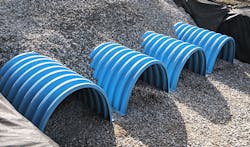Plastic Chambers for Controlling NPS
Nonpoint Source Pollution (NPS), one of the largest environmental concerns of this age, is the collection and conveyance of precipitation that moves over or through the ground. This runoff eventually deposits into the surrounding lakes, rivers, coastal or groundwaters, and wetlands. Runoff often carries pollutants, chemicals and garbage; one can imagine the environmental impact if the proper precautions are not taken.
When a previously permeable surface becomes impervious, such as with the installation of a parking lot or astroturf field, storm water runoff is exacerbated. Because of this, each state has regulations to control NPS and direct any runoff into a storm water management system.
While there are many types of storm water systems, one commonly used is the open bottom, plastic storm water chamber. Chambers are arch-shaped, durable plastic structures that differ in size and capacity by model. They can be used for storm water retention/detention and can do so simultaneously if required. Whether the chamber is used for retention or detention depends on the inlet pipe location, allowing engineers to customize the system. Chambers are placed underground in trenches or beds to optimize above-ground development. Often, a designated row of chambers covered with geotextile fabric is employed for water quality, first-flush containment and as an access point for system maintenance. This row is then jetted out to remove contaminants. CULTEC's Separator Row for water quality has been third-party verified for TSS removal.
Less expensive than pipe or concrete systems, subsurface plastic chambers have a smaller design footprint and can be stored on site on pallets. With varying project constraints, such as workable elevations or storage volume requirements, an extensive product line is essential. CULTEC offers a large product line; able to accommodate most site parameters with sizes ranging from 8.5 in. to 4 ft-tall. Overall, plastic chambers are a smart choice for reliable, economical storm water management.
Editor's Note: Scranton Gillette Communications and the SGC Water Group are not liable for the accuracy, efficacy and validity of the claims made in this piece. The views expressed in this content do not reflect the position of the editorial teams of Water & Wastes Digest, Water Quality Products and Storm Water Solutions.
